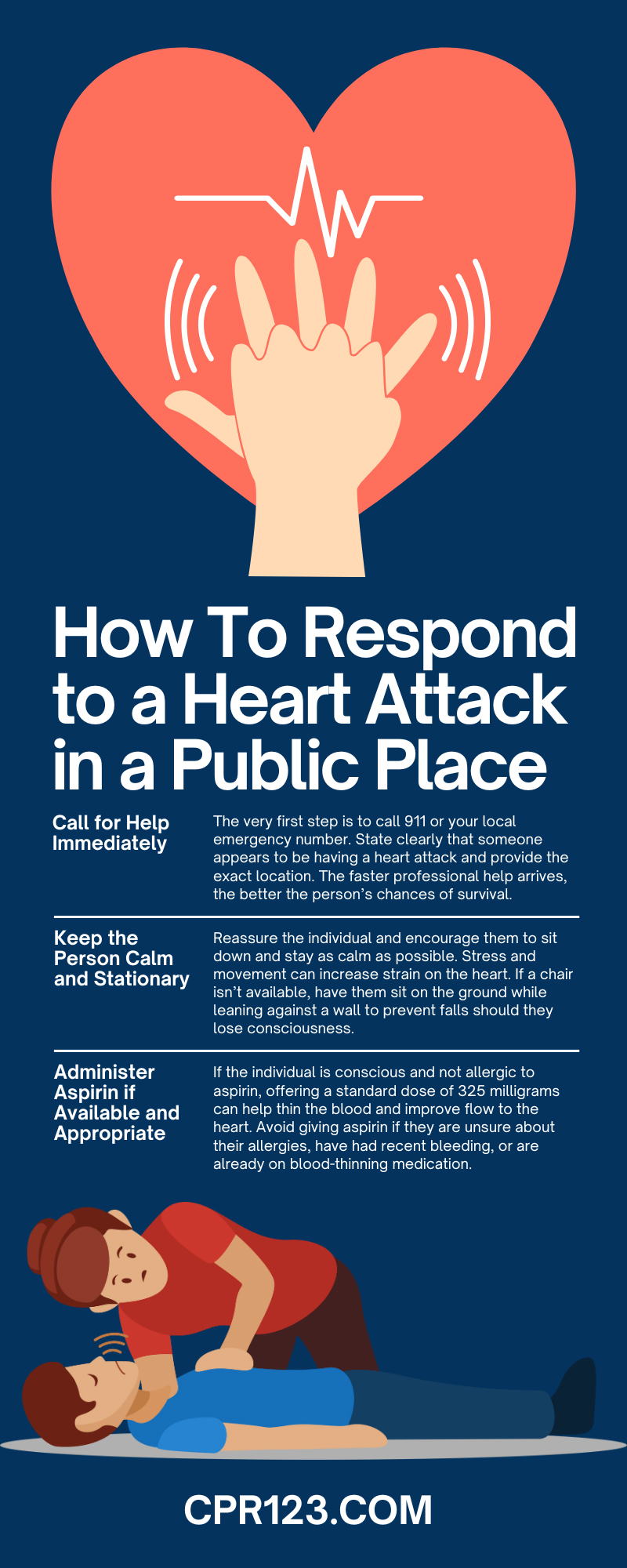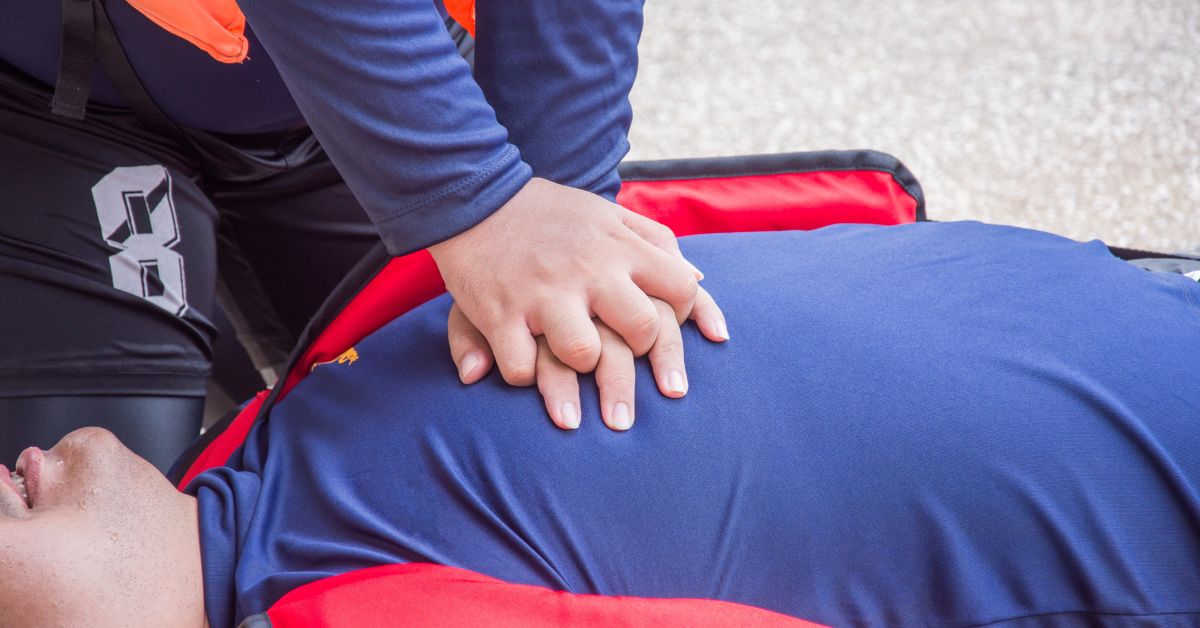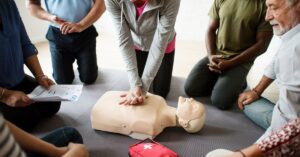A heart attack is one of the most critical medical emergencies that can happen anywhere, at any time. Acting quickly and effectively during such moments can save a life. But what should you do if you witness a heart attack in public?
Discover how to respond to a heart attack in a public place so that you can recognize the signs and prepare yourself for future emergencies by acquiring lifesaving skills. After reading this, you’ll be equipped with essential knowledge that could make a difference in a life-threatening situation.
Recognizing the Signs of a Heart Attack
The first step in responding to a heart attack is identifying the symptoms. Heart attack symptoms aren’t always as dramatic as shown in movies, where someone clutches their chest and collapses.
They can vary from individual to individual and may be subtle, making it essential to know what to look for.
- Chest discomfort: This includes a squeezing sensation often accompanied by pain, pressure, or fullness on the left side or toward the center of the chest. It may last for several minutes or feel like it comes and goes.
- Upper body pain: Pain often radiates to the arms, shoulders, back, neck, jaw, or stomach.
- Shortness of breath: This can occur with or without chest pain and often feels like you’re struggling to breathe.
- Other symptoms: You might observe cold sweats, nausea, lightheadedness, or fatigue.
Silent Heart Attacks
Surprisingly, some heart attacks, known as “silent” heart attacks, present no noticeable symptoms.
These are more common in older adults, people with diabetes, or women. While silent heart attacks can be tricky to spot, you should always take any unusual physical discomfort seriously and act quickly.
Responding to a Heart Attack in a Public Place
When someone displays signs of a heart attack, every second counts. Your response can mean the difference between life and death. Learn how to act swiftly and appropriately if you notice someone experiencing heart attack symptoms in public.
Call for Help Immediately
The very first step is to call 911 or your local emergency number. State clearly that someone appears to be having a heart attack and provide the exact location. The faster professional help arrives, the better the person’s chances of survival.
Keep the Person Calm and Stationary
Reassure the individual and encourage them to sit down and stay as calm as possible. Stress and movement can increase strain on the heart. If a chair isn’t available, have them sit on the ground while leaning against a wall to prevent falls should they lose consciousness.
Administer Aspirin if Available and Appropriate
If the individual is conscious and not allergic to aspirin, offering a standard dose of 325 milligrams can help thin the blood and improve flow to the heart. Avoid giving aspirin if they are unsure about their allergies, have had recent bleeding, or are already on blood-thinning medication.
Prepare for CPR or Use an AED
If the person becomes unresponsive and is not breathing normally, it’s critical to begin cardiopulmonary resuscitation (CPR). Instruct another to look for an Automated External Defibrillator (AEDs), as these machines can restore normal heart rhythm. Make sure you are aware of how to locate and use an AED in common environments like malls, offices, or gyms.
Stay With the Individual Until Help Arrives
Do not leave the person unattended. Talk to them reassuringly and monitor their condition while waiting for emergency medical services (EMS). If their condition worsens, be ready to adjust your response, such as activating CPR if necessary.
Mastering CPR and AED Use
Performing CPR and using AEDs are essential skills everyone should know. These techniques dramatically increase survival rates when a heart attack or cardiac arrest occurs. Learn how to perform CPR and properly use an AED.
How To Perform CPR:
- Step 1: Ensure the individual is on a firm, flat surface.
- Step 2: Place one hand over the other at the center of the chest, keeping your arms straight.
- Step 3: Compress the chest at least two inches deep, repeatedly pushing fast and hard at a rate of 100 to 120 compressions per minute.
- Step 4: Keep going until first responders arrive or the individual shows signs of recovery.
Using an AED:
- Locate the AED: These are often available in public places like airports, shopping centers, and schools.
- Turn it on: Follow the device’s voice prompts, which will guide you step-by-step.
- Attach the pads: Place the adhesive pads onto the individual’s chest as directed on the AED diagram.
- Deliver the shock (if advised): The device will analyze the rhythm of the person’s heart and determine if a shock is necessary. Stay clear of the individual while the device administers the shock.
- Resume CPR: Continue CPR immediately after you administer the shock, as AEDs typically require ongoing compressions for effectiveness.
Why You Should Get CPR Certification
While it’s possible to perform basic CPR or use an AED without formal training, obtaining a CPR certification equips you with the confidence and knowledge to respond effectively in emergencies. Certification guarantees that your skills are up-to-date and in line with current guidelines.
If you’re already certified, regular Basic Life Support (BLS) recertification courses are essential. These courses are widely available and provide a refresher on lifesaving skills, including updates on CPR techniques, AED applications, and other emergency protocols.
By staying certified, you are prepared to act decisively in a high-stakes situation. Sign up for one of CPR123’s many CPR courses to get certified today. It will be the perfect way to commemorate American Heart Month!
Prevention Is Key
While knowing how to respond to heart attacks is always important, prevention remains the best approach.
Healthy Lifestyle Choices
- Eat a balanced diet: Focus on meals rich in fruits, vegetables, whole grains, lean proteins, and healthy fats.
- Stay active: Aim for at least 30 minutes of moderate exercise five days a week.
- Quit smoking: Smoking significantly raises the risk of heart disease. Seek support to quit if necessary.
- Manage stress: Chronic stress can strain your heart. Consider yoga, meditation, or professional counseling to manage mental well-being.
Regular Check-Ups
High blood pressure, high cholesterol, and diabetes are significant risk factors for heart attacks. Regular check-ups allow you to monitor your health and make early lifestyle adjustments to combat these conditions.
Save a Life With Knowledge and Action
By understanding how to respond to a heart attack in a public place, you position yourself as a lifesaving resource in times of crisis.
Preparation isn’t just about being ready for emergencies—it’s also a powerful way to create safer communities. February is American Heart Month so consider enrolling in a CPR certification class with CPR123 to make sure you’re able to save a life when it matters most. Together, we can build a more prepared, compassionate world.








